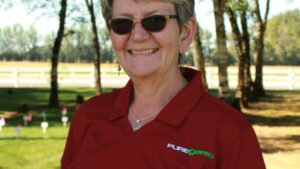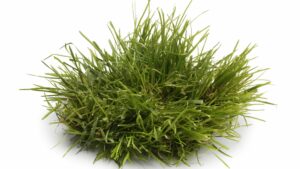Kentucky bluegrass. This species, known as Poa pratensis, is not usually associated with production agriculture, but it does play an unrecognized but important role in the lives of most Canadian homeowners.
The commercial sod industry in Canada and much of the United States is widely recognized. The evolution of progressively improved grass varieties is appreciated by a handful of producers in this vital industry.

Poa pratensis an apomictic species. In layman’s terms, it is cross-pollinating the flower’s pollen to fertilize the endosperm. While 99% apomictic, it may produce 1% cross pollinated seed. This pollination occurs in nighttime hours and that is when new pollen may be introduced.
Some American and European breeders continue to use this process; this resulted in most early varieties being the result of their discoveries. The first such widely recognized variety was Merion. It was discovered growing on a few tees of the Merion Golf Club in Ardmore, Pennsylvania. Their superintendent, Joe Valentine, took plugs to the USDA agricultural station in Beltsville, Maryland.
The variety’s characteristics included a strong dark green colour, a dense root system conferring some drought tolerance, as well as the roots forming a strong carpet-like sod. Its appearance coincided with the birth and growth of the sod industry in Canada circa 1955 and much of the United States.
Sod installers during this period would buy a pasture field from a livestock producer and strip the sod. They noticed that the sod in the farm’s laneway was the best and strongest. This was attributed to the traffic from the cows’ hooves, forcing out the weaker grasses and letting the bluegrass portion dominate.
Around this time, a well-travelled and experienced farmer from the Alliston, Ont., area — William Ruthven — made the decision to start growing sod commercially. He purchased Merion seed and his product was called Merion Sod. Soon, other growers followed him into this lucrative production, and it became standard to plant some areas with 100% Merion, but larger areas in blends of 30% to 50% Merion and the balance common or no variety stated.
Because of the apomictic structure of this species, varieties tended to be very uniform, both a strength and a weakness. Merion, for example, was susceptible to powdery mildew and leaf rust and when such a disease struck, the entire crop was affected. By blending two or more varieties, it ameliorated this risk. Plant breeders were soon on the hunt for more new varieties. Nugget, a dark green variety, was discovered on the ocean shore near Palmer, Alaska, and was commercialized. Touchdown was found on a fairway on the National Golf Links of America at Long Islands, Southampton.
Superintendent Tom Rewinski brought this discovery to the famed turf program at Rutgers University, which commercialized it. It was hugely popular with the sod industry largely for its disease resistance and strong root system.
The late Dr. C. Reed Funk, turfgrass researcher at Rutgers University, was actively pursuing a system of synthetization along with his grad student, Dr. G.W. Pepin. The first such crossbred varieties included America, Adelphi and Bonnieblue, which were released into the market. Concurrently, there were active breeding programs in Europe, mainly Holland and Scandinavia, and to a lesser extent, Germany.
The most successful variety from this basket of research was Fylking 0217, released to the seed division of Maple Leaf Mills and distributed in North America and Asia and Baron from the large Dutch company Barenbrug.
Currently in Ontario there are 4,500 hectares of Kentucky bluegrass sold annually. The seeding rate is approximately 100 to 125 kilograms per hectare. As development land prices have increased, building lots have diminished in size.
Producing high quality seed of Kentucky bluegrass is demanding. Most successful production has been situated in Idaho and Washington.
The area became famous for its quality seed when the Jacklin Seed Company of Spokane successfully produced high yields of the initial variety Merion. Kentucky bluegrass sod is a strong contributor to a green world.
—Martin Pick is a seed industry legend and co-founder of Pickseed Canada












